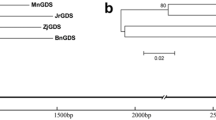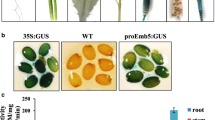Abstract
The ENOD40 gene is induced early during Rhizobium-legume symbiosis and has probably a primary role in the nodule organogenesis. In this paper we show that the 1.7 kb 5′-flanking region of the GmENOD40(2) is able to drive the expression of a gusA-int marker in transgenic Arabidopsis thaliana. The promoter activity is developmentally regulated and the major activity is detected in the root and in the stigma.
Similar content being viewed by others
References
Asad S, Fang Y, Wycoff KL, Hirsch AM: Isolation and characterization of cDNA and genomic clones of MsENOD40; transcripts are detected in meristematic cells of alfalfa. Protoplasma 183: 10–23 (1994).
Charon C, Johansson C, Kondorosi E, Kondorosi A, Crespi M: Enod40 induces differentiation and division of root cortical cells in legumes. Proc Natl Acad Sci USA 94: 8901–8906 (1997).
de Jong AJ, Heidstra R, Spaink HP, Hartog MV, Meijer EA, Hendriks T, Lo Schiavo F, Terzi M, Bisseling T, van Kammen A, De Vries SC: Rhizobium lipooligosaccharides rescue a carrot somatic embryo mutant. Plant Cell 5: 615–620 (1993).
Dudley ME, Jacobs TW, Long SR: Microscopic studies of cell divisions induced in alfalfa roots by Rhizobium meliloti. Planta 171: 289–301 (1987).
Fang Y, Hirsch A: Studying early nodulin gene ENOD40 expression and induction by nodulation factor and cytokinin in transgenic alfalfa. Plant Physiol 116: 53–68 (1998).
Heidstra R, Geurts R, Franssen H, Spaink HP, van Kammen A, Bisseling T: Root hair deformation activity of nodulation factors and their fate on Vicia sativa. Plant Physiol 105: 787–797 (1994).
Heidstra R, Nilsen G, Martinez-Abarca F, van Kammen A, Bisseling T: Nod factor induced expression of leghemoglobin to study the mechanism of NH4NO3 inhibition on root hair deformation. Mol Plant Microbe Interact 10: 215–220 (1997).
Hirsch AM: Developmental biology of legume nodulation. Plant Physiol 122: 211–237 (1992).
Jacobsen-Lyon K, Jensen EO, Jorgensen J-E, Marcker KA, Peacock WJ and Dennis ES: Symbiotic and nonsymbiotic hemoglobin genes of Casuarina glauca. Plant Cell 7: 213–223 (1995).
Jefferson R A: Assaying chimeric genes in plants: the GUS gene fusion system. Plant Mol Biol Rep 5: 387–405 (1987).
Kouchi H, Hata S: Isolation and characterization of novel nodulin cDNAs representing genes expressed at early stages of soybean nodule development. Mol Gen Genet 238: 106–119 (1993).
Lazo GR, Stein PA, Ludwig RA: A DNA transformation competent Arabidopsis genomic library in Agrobacterium. Bio/technology 9: 963–967 (1991).
Lerouge P, Roche P, Faucher C, Maillet F, Truchet G, Promé JC, Denarié J: Symbiotic host-specificity of Rhizobium meliloti is determined by a sulphated and acylated glucosamine oligosaccharide signal. Nature 344: 781–784 (1990).
Malamy JE, Benfey PN: Organization and cell differentiation in lateral roots of Arabidopsis thaliana. Development 124: 33–44 (1997).
Martirani L, Stiller J, Mirabella R, Alfano F, Lamberti A, Radutoiu SE, Iaccarino M, Gresshoff PM, Chiurazzi M: TDNA tagging of nodulation-and root-related genes in Lotus japonicus. Expression patterns, and potential for promotertrapping and insertional mutagenesis (submitted).
Marton L, Browse J: Facile transformation of Arabidopsis. Plant Cell Rep 10: 235–239 (1991).
Oppenheimer DG, Herman PL, Sivakumaran S, Esch, J, Marks D: A myb gene required for leaf trichome differentiation in Arabidopsis is expressed in stipules. Cell 67: 483–493 (1991).
Papadopoulou K, Roussis A, Katinakis P: Phaseolus ENOD40 is involved in symbiotic and non-symbiotic organogenetic processes: expression during nodule and lateral root development. Plant Mol Biol 30: 403–417 (1996).
Roussis A, van de Sande K, Papadopoulou K, Drenth J, Bisseling T, Franssen H, Katinakis P: Characterization of the soybean gene GmENOD40-2. J Exp Bot 46: 719–724 (1995).
Smyth DR, Bowman JL, Meyerowitz EM: Early flower development in Arabidopsis. Plant Cell 2: 755–767 (1990).
Szczyglowski K, Szabados L, Fujimoto SY, Silver D and de Bruijn FJ: Functional analysis of the Sesbania rostrata leghemoglobin glb3 gene 50-upstream region in transgenic Lotus corniculatus and Nicotiana tabacum plants. Plant Cell 2: 973–986 (1990).
Truchet G, Barker DG, Camut S, de Billy F, Vasse J, Huguet T: Alfalfa nodulation in the absence of Rhizobium. Mol Gen Genet 219: 65–68 (1989).
van de Sande K, Pawlowski K, Czaja I, Wieneke U, Schell J, Schmidt J, Walden R, Matvienko M, Wellink J, van Kammen A, Franssen H, Bisseling T: Modification of phytohormone response by a peptide encoded by ENOD40 of legumes and a nonlegume. Science 273: 370–373 (1996).
Yang W-C, de Blank C, Meskiene I, Hirt H, Bakker J, van Kammen A, Franssen H and Bisseling T: Rhizobium Nod factors reactivate the cell cycle during infection and nodule primordium formation, but the cycle is only completed in primordium formation. Plant Cell 6: 1415–1426 (1994).
Author information
Authors and Affiliations
Rights and permissions
About this article
Cite this article
Mirabella, R., Martirani, L., Lamberti, A. et al. The soybean ENOD40(2) promoter is active in Arabidopsis thaliana and is temporally and spatially regulated. Plant Mol Biol 39, 177–181 (1999). https://doi.org/10.1023/A:1006146627301
Issue Date:
DOI: https://doi.org/10.1023/A:1006146627301




